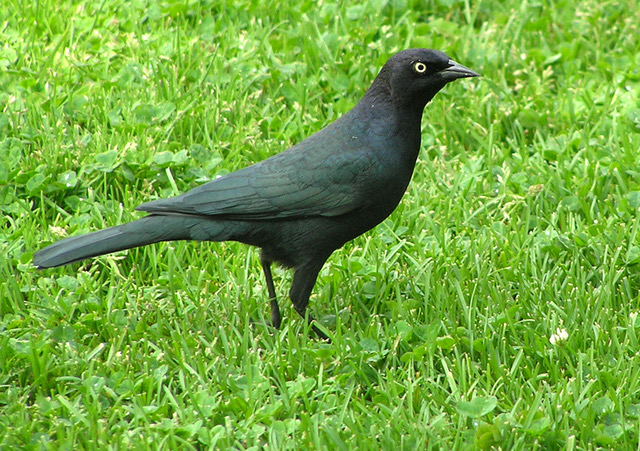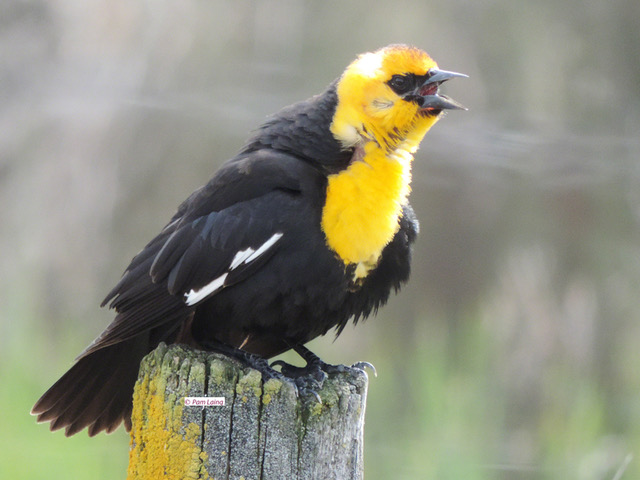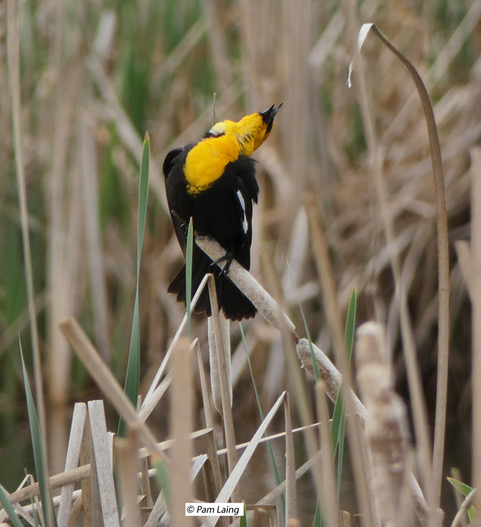Red-winged Blackbird, Yellow-headed Blackbird, and Brewer’s Blackbird
One and perhaps two of today’s birds are probably familiar to you, the other might not be. They are all blackbirds, members of the Icterid family, a group comprising (in our valley) these two, as well as Western Meadowlark and Bullock’s Oriole, Brown-headed Cowbird and the rarer Rusty Blackbird and Bobolink. All are characterized by a longish straight beak and roughly the same general body shape. It’s interesting to compare how different they look when plumage is foremost in mind.

Red-winged Blackbirds are the familiar inhabitants of cattail marshes. Early spring resounds with their calls, the males vying for female attention by posing in prominent places and singing while flashing their red shoulder patches. Many people consider their songs one of the surest signs of approaching spring, as they begin to ‘tune up’ long before the days noticeably lengthen and grow warmer.

The bird’s body and longish tail is all-black and the eye is also black. Only the beak, paler and pointed, and the shoulder patches, red outlined in yellow, are different. Female Red-winged Blackbirds are often misidentified or puzzling to newer birders. Their coloration is subdued, as they will be incubating the eggs and need to remain less obvious. Streaks of dark brown on an off-white underpart, a light brown ‘eyebrow’ and some other facial markings are her field marks. But her beak is distinctive and her beak and size match that of her mate. In size Red-winged Blackbirds are about 7 – 10”/~18-25cm, with a wingspan of 11 – 14”/~28-35cm.
They raise one or sometimes two broods a year from 3 or 4 eggs laid in their cup-shaped nests, woven with mud and grasses and tucked down into the denser reeds or cattails. Males with the brightest shoulder patches and loudest songs attract the most interest, and will mate with several females. Food consists of seeds and grains, and largely insects when breeding and raising young.
You will rarely see male Red-winged Blackbirds in or near marshes in our valley during the colder months. Instead they gather in large flocks with other males and frequent the landfill or around feedlots where food is abundant. Females, on the other hand, mostly migrate further south, only a few staying in the Okanagan over winter. I guess both genders are having the winter ‘off’ after the busy days of mating and feeding young are over.

Our second blackbird is the Brewer’s Blackbird, which you may or may not know. Unlike the marsh-loving birds above, these seem to prefer areas disturbed by humans to natural ones throughout much of their range, which is probably why their numbers have increased over the past few decades. Male Brewer’s Blackbirds are also all black, though their feathers have a distinctive iridescent sheen in certain lights. Their eyes are yellow and there are no colours anywhere else on their bodies. Females are plain brown overall, with a brown eye. While their bodies are slightly larger than those of Red-winged Blackbirds, their wingspan is slightly shorter.


They too build a cup-shaped nest, usually of stem and twig framework lined with grasses and animal hair. They forage on the ground for many species of insects during the breeding season, also snails, seeds, grains and occasionally fruit in late summer. You will often see them in city parks strutting upright over the grass, checking out picnic tables for leftovers, and then darting forward to feed at an inclined angle often with their tails raised. I usually see my first Brewer’s Blackbirds by the end of March, since most of them migrate south into the western US States for the winter and only come north when the days lengthen and warm.

Our third species and the latest to arrive is another marsh inhabitant, the Yellow-headed Blackbird. The name tells you what a male looks like; an almost all-black bird with a distinctive bright yellow head and upper breast. There is a dark patch surrounding the bird’s black eye and a black beak. Only a sliver of white shows in the wings when the bird is perched, but it’s conspicuous when the bird flies. Female Yellow-headed Blackbirds are much more subdued in appearance, brownish with yellowish face and upper breast.

Chunkier than the Red-winged Blackbird though roughly the same size, Yellow-headed Blackbirds prefer marshes where the cattails are more extensive or there is more water surrounding them. They raise one brood a year, their cup of plant strips woven into standing aquatic vegetation.

The song of the Yellow-headed Blackbird is, um, not exactly melodious. To me it sounds as though the bird is trying to swallow itself down its own throat, and gagging in the process! It is carrying and distinctive, however, and obviously the females find it alluring.
A few Yellow-headed Blackbirds are occasionally seen in the Okanagan in winter, but I usually see my first ones each year in early April. A good place to see them in Kelowna is part of the Thomson Brook Marsh immediately to the south of the Capital News Centre, while another is Robert Lake in North Glenmore. You can also see them around the two ponds on the Glenmore Road between Winfield and Kelowna, especially Bubna’s Pond, the southern one. Yellow-headed Blackbirds are birds of the western Provinces and States, rarely found east of Manitoba.
Keep an eye out for all these blackbirds as the spring advances into early summer. And think about how their shape is basically the same, with only a few plumage differences to mark them visually as distinct. Next time we’ll look at more of the similar-shaped Icterids, which will be with us for the summer. Happy birding!
Pam Laing
Okanagan birder

It’s always a treat to read your informative articles, Pam. Thanks for including local areas where we can go to see them.
Hello Pam; Your photos are incredible. You certainly capture the moment with your camera. It’s interesting reading your comments on bird behaviour. Your knowledge of birds is extensive. Your Blog is great reading and a great reminder of birding back home. I look forward to your Blogs. Thanks for your contribution to the Lake Country Museum site.